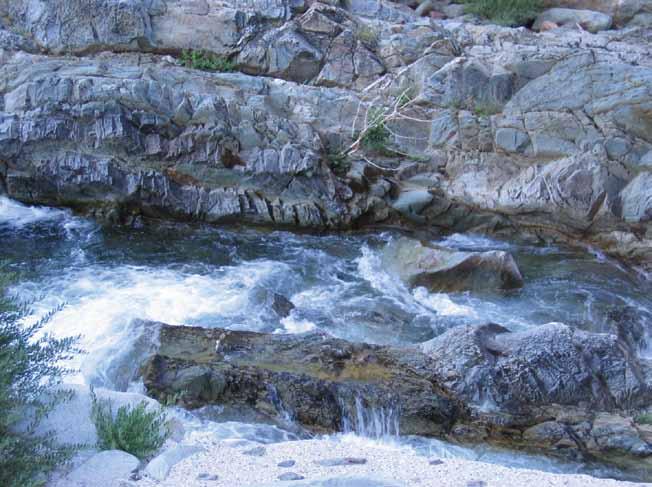The Four Seasons in the Mountains, Part 1
By Lydia Cartwright Rosen
April 24, 2024

Spring. North fork of the Yuba River — Photo by Lydia Rosen
Taken with permission from Mountain Springs
This view of the northern Sierra includes many of the same natural seasonal progressions in the few other small towns both east and west of Sierra City in Sierra County, but of course with some differences because of elevation and terrain. The wide expanse of Sierra Valley and the lower elevations near Camptonville experience somewhat different conditions. Because I grew up in Sierra City, and am most familiar with it and the ten miles of deep forest from there to the Yuba Summit, and also with the Lakes Basin area north of the Sierra Buttes, my impressions are necessarily concentrated with those areas.
The Four Seasons in the Northern Sierra Nevada
The changing of the seasons in the northern Sierra is a basic, rhythmic movement, an annual ritual of distinct phases to which mountain inhabitants, both human and animal, learn to anticipate and respond. In the mountains, the seasons proclaim themselves distinctly. Just as beloved children are viewed as distinct by their parents, the seasons appear not as more or less beautiful, but rather, as separate and unique. With the turning of the seasons, mountain inhabitants—both people and wild things—turn this way or that, anticipating and responding to the moods the mountains seem to demand. This element of demand and yielding between earth and living creatures is a fundamental, sensual communication that is at once primitive and highly refined.
So it is, in spring, when the snow melts and seeps down through the cracked and swollen earth, and the annual healing of winter ravages begins, mountain creatures, too, throw off the burden of cold winds and grey skies and join a vast recreation. Spring always announces itself timidly with many false starts before reaching full bloom, causing you to sense its approach before it visibly appears. Once the snow begins to melt, the smell of wet, stirred earth drawn up by the sun is harbinger to the approach of brighter days. To again find houses, roads, and forests free of their white mantle is a perpetually surprising discovery. Mud that resulted from the long communion of snow and earth is lumped and caked along the roads; everywhere is the ooze and trickle of little snow-released streams running down to merge with the torrents of spring floods in the North Yuba. Under the firs, pines, and cedars, the buds of dogwood trees begin to swell, bursting, with the growing warmth of the sun, into full-blown white blossoms. The trickling comment of snow-melt, the snapping of new branches arching toward the sun, the incessant croaking of frogs announce that the forest is waking up from its long cold hibernation. On the nine thousand-foot rounded face of the Sierra Buttes towering five thousand feet directly above my home in Sierra City, snow clings late into spring. In the deep ravines below the Buttes and in the ravines on the north-facing heights across the narrow canyon carved by the Yuba, the snow often builds up until the weight can no longer be sustained and rumbles down in a great rush. In late spring, fruit trees blossom in gardens; crocuses, which bloom only a few days of the year, unfold; and the air is infused with the sweet, distinctive perfume of violets. Spring here is a time of much movement and sound. Birds that migrated south in late fall return to get busy with nest-building, clouds move swiftly across pale blue skies, and gardeners begin to clear and turn the earth for planting. As the blossoms drift down, the days become longer and warmer, and the approach of summer is visible in the thickening of leaves and the height of the grass.
Mountain Springs can be purchased at the Downieville Historical Museum, Sierra Country Store in Sierra City, Bassett’s Station, Graeagle Store, or directly by emailing lcrosen@yahoo.com.
Featured Articles

CDFW Injects Chinook Salmon Eggs Into North Yuba →
November 13, 2025
CDFW’s pilot program reintroduces chinook salmon to North Yuba River after decades.
Helicopter Logging Project Underway Near Downieville →
November 13, 2025
Downieville Honors Veterans with Parade and Luncheon →
November 12, 2025
FEMA Unveils Expanded Floodplain Maps for Sierra Valley →
November 4, 2025
Fish & Wildlife Lethally Removes Sierra Valley Problem Wolves →
October 27, 2025